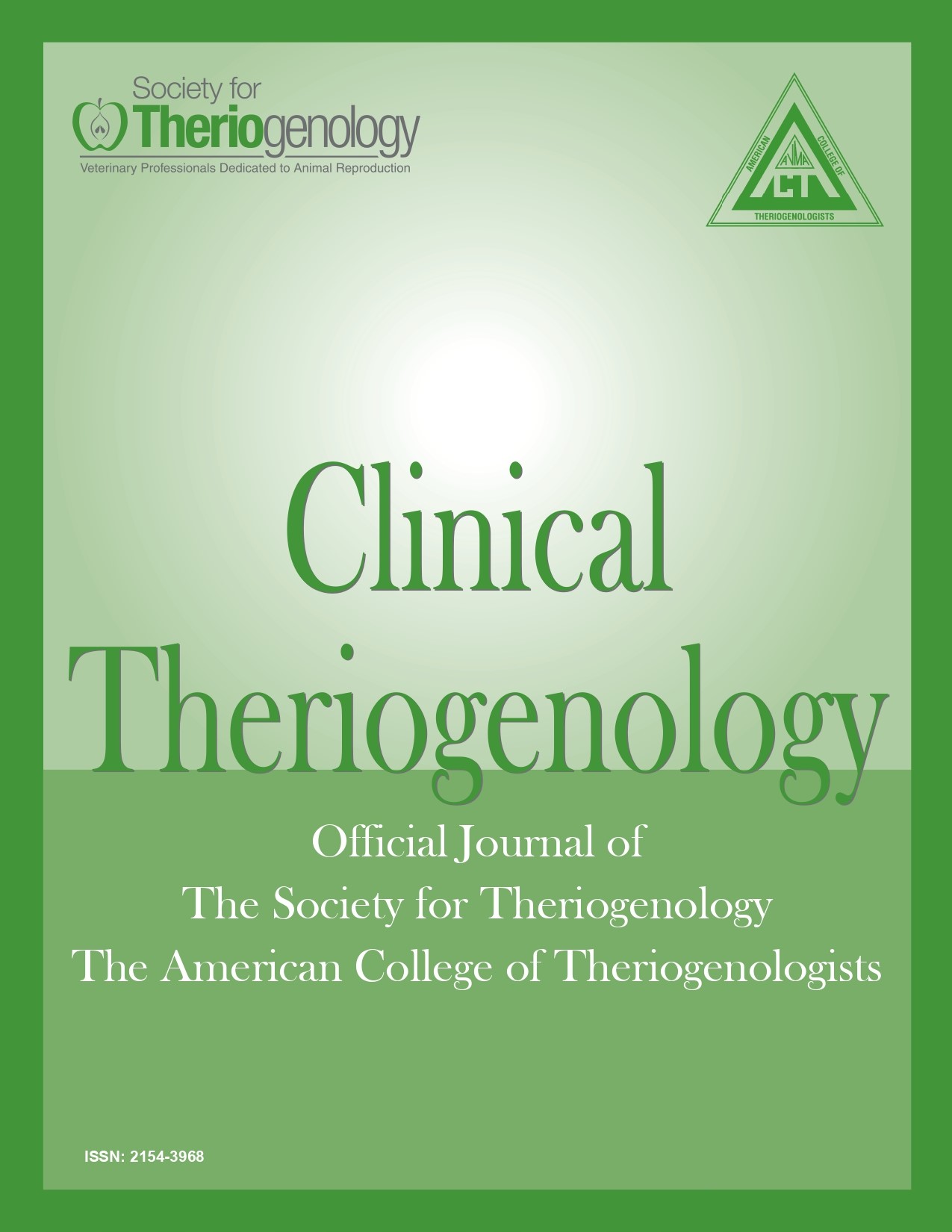Pregnancy and spontaneous partial abortion associated with salmonella in a dog
Abstract
A 2-year mixed breed dog was presented on day 50 after breeding for an emergency condition (greenish brown vulvar discharge and abortion). The patient was underweight (lower body condition score), had nonfetid vulvar discharge, and was negative for Ferguson reflux. Patient had 10 premature fetuses (determined via transabdominal ultrasonography and radiography). Serum progesterone concentration was 1.25 ng/ml. Overnight hospitalization therapies included intravenous fluids, terbutaline, fenbendazole, altrenogest, progesterone, and antibiotics. Based on vaginal discharge culture results (salmonella), antibiotics treatment was altered. Three days later, neutrophilia with left shift and a fetal death were observed. Because cesarean surgery with ovariohysterectomy was declined by the owner, altrenogest and terbutaline treatments were discontinued to permit whelping. Patient was in dystocia after delivering 2 stillborn and 2 live pups. One pup was delivered medically and 1 necrotic pup via cesarean surgery. Intrauterine culture (collected during surgery) was negative. On day 7 postpartum, the patient and 3 remaining pups were healthy. This case demonstrated the difficulties of managing fetal-placental infections.
Downloads
References
2. Johnston SD, Root Kustritz MV, Olson PN: Canine pregnancy. In: Kersey R, LeMelledo D, eds. Canine and feline theriogenology. Philadelphia, PA: Saunders; 2001, pp. 66–104.
3. Pretzer SD: Bacterial and protozoal causes of pregnancy loss in the bitch and queen. Theriogenology 2008;70:320–326. doi: 10.1016/j.theriogenology.2008.04.035
4. Purina. Body condition system. Purina. Available from: https://www.purina.com/sites/g/files/auxxlc196/files/2021-01/BodyCondition_Dog_122120.pdf [cited 26 April 2022].
5. IRIS International Renal Interest Society. Urine specific gravity. IRIS International Renal Interest Society. Available from: http://lnnk.in/eYf7 [cited 29 April 2022].
6. Pierini A, Gori E, Lippi I, et al: Neutrophil-to-lymphocyte ratio, nucleated red blood cells and erythrocyte abnormalities in canine systemic inflammatory response syndrome. Res Vet Sci. 2019;126:150–154. doi: 10.1016/j.rvsc.2019.08.028
7. Nyland TG, Mattoon JS: Ovaries and uterus. In: Callen PW, ed. Small animal diagnostic ultrasound. Saint Louis, MO: WB Saunders Co.; 2002, pp. 231–249.
8. Dróżdż M, Małaszczuk M, Paluch E, et al: Zoonotic potential and prevalence of Salmonella serovars isolated from pets. Infect Ecol Epidemiol 2021;11:1–20. doi: 10.1080/20008686.2021.1975530
9. Cobb MA, Stavisky J: Salmonella infections in dogs and cats. In: Barrow PA, Methner U, eds. Salmonella in domestic animals. 2nd ed. Loughborough: CAB International; 2013, pp. 318–336.
10. Andruzzi MN, Krath ML, Lawhon SD, et al: Salmonella enterica subspecies houtenae as an opportunistic pathogen in a case of meningoencephalomyelitis and bacteriuria in a dog. BMC Vet Res 2020;16:1–5. doi: 10.1186/s12917-020-02652-5
11. Allen-Durrance A, Mazzaccari KM, Woliver CL: Bacteremia and late-term abortion secondary to salmonellosis in a dog. J Am Anim Hosp Assoc 2022;58:262–264. doi: 10.5326/JAAHA-MS-7237
12. Ellerbrock RE, Canisso IF, Podico G, et al: Diffusion of fluoroquinolones into equine fetal fluids did not induce fetal lesions after enrofloxacin treatment in early gestation. Vet J 2019;253:1–7. doi: 10.1016/j.tvjl.2019.105376
13. Rebuelto M, Loza ME: Antibiotic treatment of dogs and cats during pregnancy. Vet Med Int 2010;2010:1–8. doi: 10.4061/2010/385640
14. Mata J, Papich MG: Pharmacologic considerations in the young patient. In: Peterson ME, Kutzler MA, eds. Small animal pediatrics: the first 12 months of life. Saint Louis, MO: Saunders; 2011, pp. 232–243.
15. Frank LA, Hnilica KA, May ER, et al: Effects of sulfamethoxazole-trimethoprim on thyroid function in dogs. Am J Vet Res 2005;66:256–259. doi: 10.2460/ajvr.2005.66.256
16. McMichael M, Dhupa N: Pediatric critical care medicine: physiological considerations. Compend Contin Educ Vet 2000;22:206–214.
17. Root Kustritz MV: Use of supplemental progesterone in management of canine pregnancy. In: Concannon PW, England G, Verstegen J, III, et al: eds. Recent advances in small animal reproduction. Ithaca, NY: International Veterinary Information Service; 2001.
18. Eilts BE, Paccamonti DL, Hosgood G, et al: The use of ally-trenbolone as a progestational agent to maintain pregnancy in ovariectomized bitches. Theriogenology 1994;42:1237–1245. doi: 10.1016/0093-691X(94)90872-9
19. Concannon PW, Butler WR, Hansel W, et al: Parturition and lactation in the bitch: serum progesterone, cortisol and prolactin. Biol Reprod 1978;19:1113–1118. doi: 10.1095/biolreprod19.5.1113
20. Steinetz BG, Goldsmith LT, Hasan SH, et al: Diurnal variation of serum progesterone, but not relaxin, prolactin, or estradiol-17β in the pregnant bitch. Endocrinology 1990;127:1057–1063. doi: 10.1210/endo-127-3-1057
21. Nothling JO, De Cramer KGM: Comparing the values of progesterone in the blood of bitches as measured with a chemiluminescence immunoassay and a radioimmunoassay. Reprod Domest Anim 2018;53:1136–1141. doi: 10.1111/rda.13216
22. Vasconcelos JLM, Sangsritavong S, Tsai SJ, et al: Acute reduction in serum progesterone concentrations after feed intake in dairy cows. Theriogenology 2003;60:795–807. doi: 10.1016/S0093-691X(03)00102-X
23. Lin VH, Chen J, Liao C, et al: The rapid immunosuppression in phytohemagglutinin-activated human T cells is inhibited by the proliferative ca2+ influx induced by progesterone and analogs. Steroids 2016;111:71–78. doi: 10.1016/j.steroids.2016.01.010
24. Bartoskova A, Ondrackova P, Leva L, et al: The effects of in vitro exposure to progesterone and estradiol-17β on the activity of canine neutrophils. Vet Med (Praha) 2014;59:202–209. doi: 10.17221/7481-VETMED
25. Hertzer JN, Fujishiro M, Lawhon SD, et al: Treatment and management of salmonella prostatitis in a heartworm-positive intact male dog: a case report. BMC Vet Res 2021;17:1–6. doi: 10.1186/s12917-021-02836-7

This work is licensed under a Creative Commons Attribution-NonCommercial 4.0 International License.
Authors retain copyright of their work, with first publication rights granted to Clinical Theriogenology. Read more about copyright and licensing here.





